
The West Newton Hill NR Historic District is a residential National Register historic district in the village of West Newton, in the city of Newton, Massachusetts in the United States. It is composed of a cohesive collection of spacious houses built in the second half of the 19th century, representing the development of the West Newton area as a fashionable railroad suburb. The district was listed on the National Register of Historic Places in 1986.
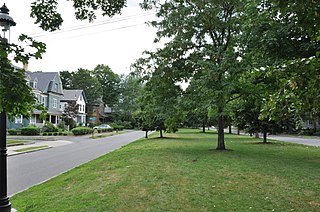
The Washington Park Historic District is a historic district in the village of Newtonville, in Newton, Massachusetts. It includes the following properties, dating to between 1870 and 1900: 4 to 97 Washington Park plus 5 and 15 Park Place. The focal point of the district is the city park which is located in the median of the street of the same name. On March 12, 2008, it was added to the National Register of Historic Places.

The Bigelow Street Historic District encompasses a uniform collection of 19th century houses on most of the length of Bigelow Street in Cambridge, Massachusetts, just northwest of Central Square. Bigelow Street was laid out in 1868, and the street was almost completely built out by 1874, resulting in a fairly uniform streetscape of Second Empire architecture. The district was added to the National Register of Historic Places in 1982.

The Harvard Street Historic District is a historic district on Harvard Street between Ellery and Hancock Streets in Cambridge, Massachusetts. It includes houses on both sides of the street, numbered from 335 to 344 inclusive, an area that marks the summit of Dana Hill. Harvard Street was laid out as a direct route from "Old Cambridge" to Boston in the early 1800s, and was run over Dana Hill over the objection of Judge Francis Dana, whose estate sat on top of the hill. The street was developed over the 19th century with a succession of high-quality houses.

The Hastings Square Historic District is a historic district that encompasses Hastings Square, a small city park in Cambridge, Massachusetts, and the residential properties that abut it. The houses that line the streets across from the park are among the finest Queen Anne houses in the city. These properties were built between 1869 and 1892, and include two houses known to be designed by architects. The Queen Anne/Shingle style house at 302 Brookline Avenue was built in 1887 to a design by Rand & Taylor, and the 1892 Queen Anne house at 75 Henry Street was designed by Hartwell and Richardson.

The Maple Avenue Historic District is a residential historic district on Maple Avenue between Marie Avenue and Broadway in Cambridge, Massachusetts, United States. It encompasses a street with a cohesive collection of well-preserved, predominantly Italianate and Second Empire, houses, in which the original spacing and setting has been preserved. It includes houses on both sides of Maple Avenue, numbered from 8 to 33, among which stand several Queen Anne and Colonial Revival houses. The district was added to the National Register of Historic Places in 1983.

Elm Hill Farm Historic District is a historic district on East Main Street east of the junction with Brookfield Road in Brookfield, Massachusetts. The major contributing element to the district is the Elm Hill Farm complex, one of the largest and most significant farms in the town for more than 100 years. The complex includes two Federal period residences, two with Queen Anne styling, and four Italianate styled outbuildings.

The Hubbard-Dawson House is a historic house in Holden, Massachusetts. This rambling 2+1⁄2-story wood-frame house is the only surviving instance of Colonial Revival and Queen Anne styling in Holden. The central portion of the house is fairly old, and may date to 1832, when a house was known to be standing on the property. The house at one time had Italianate styling, as evidenced by pre-1890s photographs, which suggest construction from the 1850s, but these decorations appear to have been added onto an architecturally older building. The house is also important for its ownership by Charles Dawson, owner of the Dawson Manufacturing Company, a major local employer between 1872 and 1910.

The Pleasant–School Street Historic District is a predominantly residential historic district in the Hyannis village of Barnstable, Massachusetts. It includes 37 properties on Pleasant and School Streets, between Main and South Streets, near the center of Hyannis. Pleasant Street was laid out in the 18th century, and School Street was laid out c. 1850, and is distinctive for its cohesive collection of Greek Revival cottages, most of which were owned by mariners active in the coasting trade. The district was listed on the National Register of Historic Places in 1987.
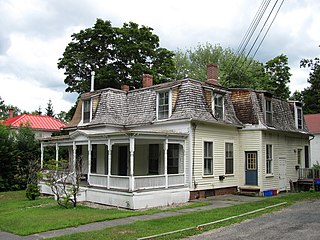
The Prospect—Gaylord Historic District is a historic district encompassing a residential area built up mostly in the late 19th century just outside the central business district of Amherst, Massachusetts. Contributing properties include most of the houses on Prospect Street, which parallels Pleasant Street, as well as properties on Gaylord and Amity Streets running west from Prospect. These houses are generally in late Victorian styles such as Queen Anne, although some, for example a workman's house at 24 Gaylord Street, are in a more vernacular style. A central element of the district is the Hope Community Church, a historically African American church built in 1912 for a congregation whose history dates to 1869. Funds for its construction were raised in part through the efforts of W.E.B. Du Bois. The district was listed on the National Register of Historic Places in 1993.

The Springfield Street Historic District is a predominantly residential historic district south of the downtown area of Chicopee, Massachusetts. It encompasses a significant number of Queen Anne style houses built in the second half of the 19th century by wealthy residents of Chicopee, as well as housing for skilled workers at the nearby textile mills. It is centered where Springfield Street and Fairview Avenue meet. The district was listed on the National Register of Historic Places in 1991.

The Acton Center Historic District encompasses the historic heart of the once-rural, now suburban, town of Acton, Massachusetts. The district includes properties on Main Street, Wood and Woodbury Lanes, Newtown, Concord, and Nagog Hill Roads, and has been the town's civic heart since its establishment in the 1730s. It was added to the National Register of Historic Places in 1983.

Meetinghouse Green Historic District encompasses the historic 17th century heart of Ipswich, Massachusetts. The district runs along North Main Street, south from its junction with High Street to the southern end of the Meetinghouse Green. It was listed on the National Register of Historic Places in 1980.
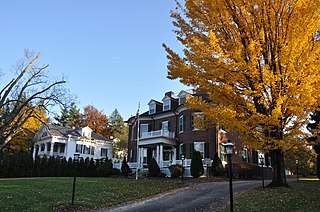
The Andover Street Historic District is a linear residential historic district in the Belvidere neighborhood of eastern Lowell, Massachusetts. The district encompasses large, fashionable houses and estates that were built between the 1860s and the 1930s. It includes properties at 245—834 Andover Street, and at 569 and 579 East Merrimack Street. The district was listed on the National Register of Historic Places in 2000.
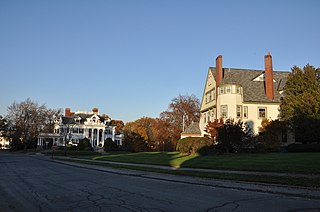
The Belvidere Hill Historic District encompasses a residential area on the east side of Lowell, Massachusetts known for its fine 19th-century houses. The area, roughly bounded by Wyman, Belmont, Fairview, and Nesmith Streets, was developed beginning in the 1850s, and was one of the finest neighborhoods in the city, home to many of its business and civic leaders. It was listed on the National Register of Historic Places in 1995.
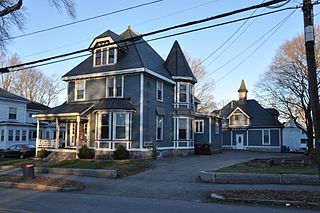
The Wilder Street Historic District is a historic district in Lowell, Massachusetts. The section of Wilder Street between Westford Street and Branch Road contains a remarkable collection of large late 19th-century houses. About one dozen wealthy businessmen built elaborate houses in Queen Anne, Italianate, Stick, and Second Empire styles in this area, which was developed by its landowner, Charles Wilder, and it was considered one of the city's most fashionable addresses of the time.

The J. M. Cheney Rental House is a historic house at 32 Edwards Street in Southbridge, Massachusetts. It is a well-preserved vernacular Victorian house exhibiting details in a number of different styles. It was built in the late 19th century, during a second phase of construction in the Hamilton Street area that replaced larger properties of wealthier owners with smaller, more densely site, middle-class housing. This house was built for J. M. Cheney, treasurer of the Litchfield Shuttle Company, who owned several properties in the area, including the adjacent Kinney House, and also lived nearby. There is no hard evidence the property was intended for use as a rental, but this seems likely.

The Glover Street Historic District is a residential historic district in Southbridge, Massachusetts. The district encompasses a cluster of nineteen houses on or adjacent to Glover Street between High and Poplar Streets. The area was fully developed beginning in the first decades of the 20th century, filling in a previous round of development that had taken place in the 1890s. These houses were targeted at Southbridge's growing middle class.

The Upper Chapin Street Historic District is a residential historic district on Chapin Street in Southbridge, Massachusetts. The district includes fourteen Victorian houses on Chapin Street, thirteen of which lie between Forest Avenue and Dresser Street, and two of which are just south of Forest. All of these houses, almost all of which were built in the 1870s, are well preserved, making it one of the most intact period neighborhoods in the city.

Elbridge Boyden (1810–1898) was a prominent 19th-century American architect from Worcester, Massachusetts, who designed numerous civil and public buildings throughout New England and other parts of the United States. Perhaps his best known works are the Taunton State Hospital (1851) and Mechanics Hall (1855) in Worcester.























